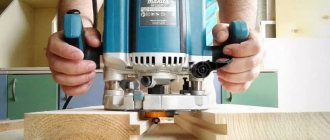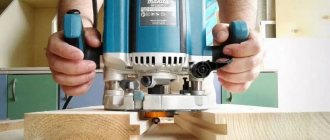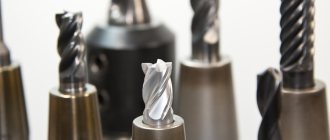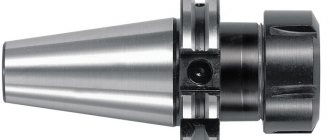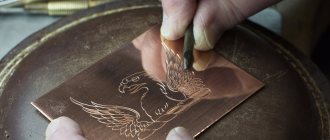A manual milling machine in the hands of a master has a universal application - with its help you can create both basic household items and masterpieces of artistic processing for decoration. However, to use it correctly, you need a suitable cutting tool. Let's look at what types of cutters there are, how they are designed, what their main purpose is, what criteria they are classified by, and how to choose the right one for a specific type of wood processing.
An example of using a wood cutter on a manual machine Source prosto-instrumenty.ru
Milling cutter for a manual wood router - what is it, device, purpose
A milling cutter is the main tool with which wood is processed. The scope of application, purpose, and result depend on its technical characteristics. Despite the fact that there are many varieties of it in terms of shape and features of the cutting edge, materials and other parameters, they are all united by the general principle of the device and the presence of standard parts:
- The cutting area, also called the head or working part. It can have different geometry, composition and blade design.
- Shank - serves as a support for the previous element. With its help, the tool is clamped in the machine chuck, and torque is also transmitted to the main part.
- Additional component. It is located on the very edge of the instrument - opposite the tail section. This could be a support bearing, locking couplings, screws, washers, calibration bushings and other devices. Their task is to simplify or expand the functionality of the cutter, for example, to arrange the cutting segments in the required sequence or to process the workpiece according to a given pattern.
Diagram of an end mill with designation of characteristics Source infradom.ru
Depending on the scope and purpose, modern wood cutters for a manual router allow you to solve the following types of problems:
- Forming edges. It is used when it is necessary to create parts of workpieces that are combined into one structure using a tongue-and-groove connection.
- Creation of cut-outs for installation of fittings.
- Production of decorative forms, cuttings, configurations.
Advice! Certain types of work require your own set of cutting tools. Therefore, before selecting specific types of cutters, it is necessary to determine what the nature, type and volume of wood processing work performed with their help will be.
Scope of application
The number of operations performed using a cutter is extremely large. Which explains their high demand.
- Rough processing of metals and non-metals - cutting, cutting, drilling, roughing.
- Drilling grooves of various shapes - grooves, grooves, screw channels, cavities of helical wheels, and so on.
- Processing corners and edges.
- Finishing and cutting , manufacturing of parts of complex geometric shapes: stamps, blades, molds.
- Artistic milling - with the help of cutters, complex elegant elements are turned out of wood, 3D images and ornaments are formed on a plane.
Classification of cutters by shank size, type of design and cutting part
Cutting tools for a manual milling machine are classified primarily according to the following three criteria:
- Tail dimensions.
- Type of construction – prefabricated, replaceable blades, monolithic, attachment/set-on.
- Material and method of sharpening the cutting edge.
Let's look at these parameters in more detail.
Set of cutters for woodworking Source instrumentgid.ru
Tail dimensions
In the characteristics of the tail section, the unit of diameter is of paramount importance. The designation must coincide with a similar parameter of the collet - the place where the cutter is mounted in the machine. As a rule, there are only two standards for this value:
- Millimeter. The most common sizes are 6, 8 and 12 mm.
- Inch. There are two main types - half and quarter inches, denoted - ½ and ¼, respectively.
When comparing two measurement systems, it turns out that products with similar diameters differ only by a small amount in size. Thus, 6 mm and ¼ or 6.35 mm cutters and 12 mm and ½ or 12.7 mm cutters look almost the same - however, the holder of a hand router is not adapted to securely hold any type of tool, like a drill chuck.
Therefore, a 12 mm cutter loaded into a ½-inch collet will not sit securely in the chuck and can easily fly out during processing. Likewise, if you load a ½-inch tool into a 12-mm holder, it may jam so much that you will have to come and repair the machine later.
The packaging indicates the size and other main parameters of the cutters Source goods.ru
The second important characteristic is the length of the shank. However, often when choosing the right tool in terms of shape, design, diameter and other parameters, it turns out that it is impossible to find one suitable for the processing conditions of the required length. In this case, special extension adapters come to the rescue.
It should also be remembered that such “helpers” should be used as a last resort and with caution. Since under loads, speeds and revolutions characteristic of modern machines, such a device will always have the property of a “weak link”.
Important! Metric and imperial cutting attachments are not interchangeable. And their use in this capacity can lead not only to damage to the workpiece or machine, but also risks injury to the operator.
See also: Catalog of companies that specialize in garden furniture and storage systems
Type of construction – prefabricated, replaceable blades, monolithic, attachment/set-on
According to the design features of wood cutters, there are 4 main types:
- Prefabricated. It is made by soldering, using refractory solders, the cutting edge to a monolithic base - the shank and the head. They are distinguished by simplicity and accessibility of production.
Example of a prefabricated cylindrical cutter Source atis-market.com
- With replaceable blades. The cutting edge is a separate element, fixed to the head with screws and which the user can replace or sharpen as necessary. Some products have up to 4 working surfaces - which significantly increases the working life of the tool.
- Monolithic. The cutting part is formed directly on the base itself - by analogy with a drill. The advantage is the minimal risk of blade tearing off. However, for prolonged use it must be periodically sharpened, which over time changes the original geometry, impairs performance and leads to the need for replacement.
- Mounted/set-on. The cutting head is connected to the shank in a movable manner. This allows you to change the distance between elements and their sequence for more varied processing of workpieces.
Recommendation! To gain experience and become familiar with processing techniques, a novice user only needs to purchase prefabricated cutters. For the more experienced and professional, kit tools are the best option.
Milling cutter with replaceable blades Source prostanki.com
Material and method of sharpening the cutting edge
The large number of revolutions and the resulting high temperature in the processing zone force tool developers to use the following 2 types of metal alloys as cutting edge materials for wood cutters for hand routers:
- Tool steel. It is marked - HSS. Designed for processing low-density wood at maximum speeds. Disadvantage: when it gets into a denser environment, the cutting edge instantly becomes dull. Therefore, it is not suitable for cutting chipboard, MDF and other similar materials.
- Carbide brazing. Designated - NM. Used for processing dense wood at medium and low speeds. Can also be used for finishing machining with high cutting edge quality. However, it is often impossible to achieve the ideal degree of smoothness when finishing with an average cutter of this type.
Frame cutters with carbide-tipped blades Source zubr-rus.ru
Face milling cutters
In accordance with GOST, end milling cutters are manufactured in two types - with small and large teeth. A diameter of 40-50 mm assumes that it is mounted on a longitudinal key. Tools 63-100 mm in diameter are mounted on an end key. End attachments can be right-handed or left-handed. If necessary, coarse cutters can have an uneven distribution around the circumference of the cutting elements. During manufacturing, the choice of the direction of the teeth, responsible for the side in which cutting will be carried out, is selected in accordance with production needs, the processing feature of a particular type of part and the design feature of milling machines.
End mills
Round and pentagonal face mills can use mechanically held inserts. Fine-toothed ones are equipped with insert knives with tips made of carbide plates. End mills are used for processing flat workpieces on vertical milling machines. Their profiling edges are only the tips of the teeth, the end cutting edges perform auxiliary work, the main cutting function falls on the side elements.
Varieties by processing method
In order to choose the right wood cutter for a hand router, you need to have an idea of what types are used for specific types of work with workpieces. According to this characteristic, cutting tools are divided into 5 main types:
- End.
- Grooved.
- Edges.
- Combined.
- Curvy.
Let us analyze in detail the main features and nuances of using each of them.
End
Having a structure similar to a drill, an end mill, however, differs from it in that its working part extends over the entire area of the cutting edge. That is, wood is sampled with the entire head part. There are the following varieties:
- Profile.
- Spherical.
- Conical.
- Spiral.
- End
- Burr cutters (cutters).
Most end mills have a universal purpose. Thus, spiral varieties allow you to drill and select grooves, quarters, and process ends; profile varieties allow you to make grooves of complex geometry, create ornaments, trim, cutters allow you to finish surfaces, engrave, select special shapes of holes and grooves.
Wood end mill set Source fainaidea.com
Grooved
The very name of the groove cutter reveals the nature of its application - the choice of grooves. However, they differ in the following modifications:
- Fillet. A semicircular sample is formed.
- Conical. Creates a V-shaped groove and is also used for carving surfaces.
- Spiral. They have a structure similar to a drill, but with a larger working part.
- T-shaped. They are used to create grooves of the type where one part slides into another.
- Dovetail. Similar to the above modification - with the difference that the cross-section of the base has the shape of a trapezoid.
- Shaped. It has a wide variety of species. It is used both for making grooves and for processing ends.
- Straight or cylindrical. Create a rectangular groove.
- Combined. They are used to form interlocking joints - when assembling linings, panels, and panels.
Slot milling cutter with performance characteristics displayed Source static-sl.insales.ru
Recommendation! When choosing a specific type of wood cutter for a hand router, you need to have an idea of what they are like in terms of workmanship, thermal strength, connection of the cutting area with the tail part and solder material. When processing hardwood, a tool with weak soldering will soon lose its longitudinal stability and quickly fail.
Edge
An edge cutter is used to create an edge that is smooth and perpendicular to the plane of the workpiece. The following types are distinguished:
- Direct. Designed to create an end perpendicular to the upper plane.
- Moulded. Straight, arched, wavy edges are formed. Used for applying complex patterns. There are also double cutters with the ability to adjust the distance between the blades.
Angle cutters
Corner is necessary to create an angular groove and the edge of an inclined or beveled plane. On single-angle cutters, the cutting blades are located vertically, along the conical body and at its end. 2-corner ones are distinguished by the location of 2 cutting edges on interacting adjacent bodies. Most often, these cutters are used in the production of milling tools.
Angle cutters
The small corner one belongs to the end group; it is equipped with a shank. The thickness of its cut is uneven - the minimum value is at the axis of rotation, the maximum value along the diameter of the created circle is at the cutting tip of the tooth. Changes in the cutting angle are reflected in uneven heating of the tool, which quickly disables it. Thinning the teeth one at a time will reduce the heat. To extend service life, it is advisable to round the top of the teeth.
Video description
Video instructions for choosing wood cutters for a beginner:
The ends of the workpieces to be joined are given a specific profile using a specific type of cutter. They are then connected by locking into a single, durable structure. The procedure is performed without additional adjustment of the selected surfaces, since the complete tools are perfectly matched to each other.
Curvy
The figuere type cutters are intended for forming panels. Example - baseboards, furniture doors, decorative strips, etc. As a rule, the tool is quite massive, and therefore machines with a power of 1.6 kW or more are used to process workpieces with it. In this case, cutters are divided into three categories:
- Horizontal. Create a panel.
- Double-sided. A panel and tenon are formed.
- Vertical. Used for selecting the profile of skirting boards.
On a note! By itself, even a good hand router and correctly selected cutters for the type of wood processing do not guarantee the planned result. For quality work, you will need a set of suitable stops and templates.
Cut-off cutters
Unlike end cutting, cutting is used for processing only in a straight line. Disc cutters are used to separate the completed part from the overall piece of material. If necessary, disc cutting machines can be used to cut grooves and grooves; they can also make a through cut on a universal milling machine or equipped with CNC. Disc machines are designed for machining cast iron and medium-hard steel.
Cut-off cutters
Briefly about the main thing
The milling cutter is the main cutting tool of a manual milling machine. Among its main parts are:
- Cutting part.
- Shank.
- Additional components.
It is used for various roughing and finishing tasks in woodworking - cutting grooves, trimming, forming interlocking joints, cutting, decorative design, etc. Milling cutters for wood processing are classified primarily according to a number of parameters such as the diameter and length of the tail, the type of design, the material from which the cutting edge is made and the method of sharpening it.
In addition, according to the method of processing the material, they differ into end, edge, groove, combined and figured. Each modification has its own characteristics and nuances of application.
Cylindrical cutters
Horizontal milling equipment uses cylindrical cutters with straight and helical teeth. Accordingly, carbide cutting edge plates will have the same appearance. Straight cutters are used for machining narrow surfaces. The screw teeth have a smooth stroke, which provides more accurate processing parameters.
Cylindrical cutter
If it is necessary to process a part with a tool inclination angle that creates maximum pressure on the axis, in order not to damage the part, twin cutters with counter-directed teeth are used. This allows you to evenly distribute the load on the axle. During the cutting process with a double cutter, the cutting edge of one element is overlapped by the edge of the counter element. Thanks to this, there is no hint on the finished part that it was processed not with a single tool, but with a composite tool.
Spline cutters
Spline or worm are used for cutting teeth on the shaft or gear of a gear transmission or spline connection along a side profile. Spline cutters are a whole group of tools with a different arrangement of teeth around the circumference of the disk or only on a cylindrical surface. They also differ in the method of fastening the cutting elements.
Spline cutter
